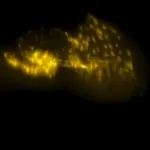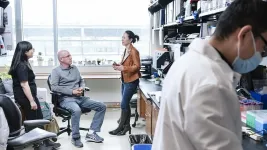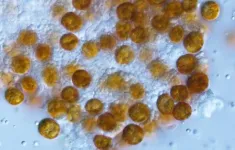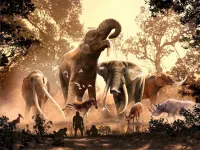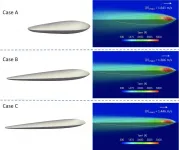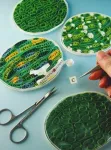(Press-News.org) What if a microscope allowed us to explore the 3D microcosm of blood vessels, nerves, and cancer cells instantaneously in virtual reality? What if it could provide views from multiple directions in real time without physically moving the specimen and worked up to 100 times faster than current technology?
UT Southwestern scientists collaborated with colleagues in England and Australia to build and test a novel optical device that converts commonly used microscopes into multiangle projection imaging systems. The invention, described in an article in today's Nature Methods, could open new avenues in advanced microscopy, the researchers say.
"It is a completely new technology, although the theoretical foundations for it can be found in old computer science literature," says corresponding author Reto Fiolka, Ph.D. Both he and co-author Kevin Dean, Ph.D., are assistant professors of cell biology and in the Lyda Hill Department of Bioinformatics at UT Southwestern.
"It is as if you are holding the biological specimen with your hand, rotating it, and inspecting it, which is an incredibly intuitive way to interact with a sample. By rapidly imaging the sample from two different perspectives, we can interactively visualize the sample in virtual reality on the fly," says Dean, director of the UTSW Microscopy Innovation Laboratory, which collaborates with researchers across campus to develop custom instruments that leverage advances in light microscopy.
Currently, acquiring 3D-image information from a microscope requires a data-intensive process, in which hundreds of 2D images of the specimen are assembled into a so-called image stack. To visualize the data, the image stack is then loaded into a graphics software program that performs computations to form two-dimensional projections from different viewing perspectives on a computer screen, the researchers explain.
"Those two steps require a lot of time and may need a very powerful and expensive computer to interact with the data," Fiolka says.
The team realized it could form projections from multiple angles by optical means, bypassing the need to acquire image stacks and rendering them with a computer. This is achieved by a simple and cost-effective unit consisting of two rotating mirrors that is inserted in front of the camera of the microscope system.
"As a result, we can do all this in real time, without any noticeable delay. Surprisingly, we can look from different angles 'live' at our samples without rotating the samples or the microscope," Fiolka says. "We believe this invention may represent a new paradigm for acquiring 3D information via a fluorescence microscope."
It also promises incredibly fast imaging. While an entire 3D-image stack may require hundreds of camera frames, the new method requires only one camera exposure.
Initially, the researchers developed the system with two common light-sheet microscopes that require a post-processing step to make sense of the data. That step is called de-skewing and essentially means rearranging the individual images to remove some distortions of the 3D-image stack. The scientists originally sought to perform this de-skewing optically.
While experimenting with the optical de-skewing method, they realized that when they used an incorrect amount of "de-skew," the projected image seemed to rotate.
"This was the aha! moment. We realized that this could be bigger than just an optical de-skewing method; that the system could work for other kinds of microscopes as well," Fiolka said.
"This study confirms the concept is more general," Dean says. "We have now applied it to various microscopes, including light-sheet and spinning disk confocal microscopy."
Using the new microscope method, they imaged calcium ions carrying signals between nerve cells in a culture dish and looked at the vasculature of a zebrafish embryo. They also rapidly imaged cancer cells in motion and a beating zebrafish heart.
INFORMATION:
UTSW co-authors include Bo-Jui Chang, Etai Sapoznik, Theresa Pohlkamp, Tamara S. Terrones, Erik S. Welf, Vasanth S. Murali, and Philippe Roudot.
Researchers from the MRC Laboratory of Molecular Biology, Cambridge, United Kingdom; Calico Life Sciences LLC, South San Francisco, California; and the Walter and Eliza Hall Institute of Medical Research and the University of Melbourne, both in Australia, also participated.
The research received support from the Cancer Prevention Research Institute of Texas (RR160057), and the National Institutes of Health (T32CA080621; F32GM117793; K25CA204526, R33CA235254, and R35GM133522). Fiolka has filed a patent for the scan unit and its applications to microscopy. Additional disclosures are in the paper. The researchers made both the data used in the study and the software code available online. Access details are in the study.
Fiolka is a member of the Harold C. Simmons Comprehensive Cancer Center. Visit the Fiolka lab here.
About UT Southwestern Medical Center
UT Southwestern, one of the premier academic medical centers in the nation, integrates pioneering biomedical research with exceptional clinical care and education. The institution's faculty has received six Nobel Prizes, and includes 24 members of the National Academy of Sciences, 16 members of the National Academy of Medicine, and 13 Howard Hughes Medical Institute Investigators. The full-time faculty of more than 2,800 is responsible for groundbreaking medical advances and is committed to translating science-driven research quickly to new clinical treatments. UT Southwestern physicians provide care in about 80 specialties to more than 117,000 hospitalized patients, more than 360,000 emergency room cases, and oversee nearly 3 million outpatient visits a year.
SAN FRANCISCO, CA--June 28, 2021--While vaccines are doing a remarkable job of slowing the COVID-19 pandemic, infected people can still die from severe illness and new medications to treat them have been slow to arise. What kills these patients in the end doesn't seem to be the virus itself, but an over-reaction of their immune system that leads to massive inflammation and tissue damage.
By studying a type of immune cells called T cells, a team of Gladstone scientists has uncovered fundamental differences between patients who overcome severe COVID-19 and those who succumb to it. The team, working together with researchers from UC San Francisco and Emory University, also found that dying patients harbor relatively large numbers of T cells able to infiltrate the lung, which may contribute ...
BUFFALO, N.Y. -- Patients with Type 2 diabetes who were prescribed SGLT2 inhibitors lost more weight than patients who received GLP-1 receptor agonists, according to a University at Buffalo-led study.
The research, which sought to evaluate the difference in weight loss caused by the antidiabetic medications -- both of which work to control blood sugar levels -- found that among 72 patients, people using SGLT2 inhibitors experienced a median weight loss of more than 6 pounds, while those on GLP-1 receptor agonists lost a median of 2.5 pounds.
The findings, published last month ...
The adult brain is more malleable than previously thought, according to researchers from the Interdisciplinary Center Herzliya. They trained a 50-year-old man, blind from birth, to "see" by ear, and found that neural circuits in his brain formed so-called topographic maps - a type of brain organization previously thought to emerge only in infancy. This finding reported recently in END ...
Rochester, Minn. -- Mayo Clinic researchers have discovered that genetic variants in a neuro-associated gene called SPTBN1 are responsible for causing a neurodevelopmental disorder. The study, published in Nature Genetics, is a first step in finding a potential therapeutic strategy for this disorder, and it increases the number of genes known to be associated with conditions that affect how the brain functions.
"The gene can now be included in genetic testing for people suspected of having a neurodevelopmental disorder, which may end the diagnostic odyssey these people and their families have endured," says Margot Cousin, Ph.D., a translational ...
UNIVERSITY PARK, Pa. -- In the late 1800s, scientists were stumped by the "yellow cells" they were observing within the tissues of certain temperate marine animals, including sea anemones, corals and jellyfish. Were these cells part of the animal or separate organisms? If separate, were they parasites or did they confer a benefit to the host?
In a paper published in the journal Nature in 1882, biologist Sir Patrick Geddes of Edinburgh University proffered that not only were these cells distinct entities, but they were also beneficial to the animals in which they lived. He assigned them to a new genus, Philozoon -- from the Greek phileo, meaning 'to love ...
Giving women in India's Madhya Pradesh state greater digital control over their wages encouraged them to enter the labor force and liberalized their beliefs about working women, concluded a new study co-authored by Yale economists Rohini Pande and Charity Troyer Moore.
The study, published in the American Economic Review, found that a relatively simple intervention directed to poor women -- providing them access to their own bank accounts and direct deposit for their earnings from a federal workfare program, along with basic training on how to use local bank kiosks -- increased the amount ...
Based on fossil finds, we know that the vast majority of species that once inhabited the earth have become extinct. For example, there are about 5,500 mammal species living on the planet today, but we know of at least 160,000 fossil species, so for every mammal species living today, there are at least 30 extinct ones. We therefore know with great certainty that the lineages of living things come and go along immense time scales. But what factors cause these lineages to come into being and disappear is still an unsolved question.
To investigate ...
Additive manufacturing has the potential to allow one to create parts or products on demand in manufacturing, automotive engineering, and even in outer space. However, it's a challenge to know in advance how a 3D printed object will perform, now and in the future.
Physical experiments -- especially for metal additive manufacturing (AM) -- are slow and costly. Even modeling these systems computationally is expensive and time-consuming.
"The problem is multi-phase and involves gas, liquids, solids, and phase transitions between them," said University of Illinois Ph.D. student Qiming ...
Early 2020 saw the world break into what has been described as a "war-like situation": a pandemic, caused by the severe acute respiratory syndrome-related coronavirus 2 (SARS-CoV-2), the likes of which majority of the living generations across most of the planet have not ever seen. This pandemic has downed economies and resulted in hundreds of thousands of deaths. At the dawn of 2021, vaccines have been deployed, but before populations can be sufficiently vaccinated, effective treatments remain the need of the hour.
Thus, other than fast-tracking research into novel drugs, scientists have also been exploring their ...
Breeding better crops through genetic engineering has been possible for decades, but the use of genetically modified plants has been limited by technical challenges and popular controversies. A new approach potentially solves both of those problems by modifying the energy-producing parts of plant cells and then removing the DNA editing tool so it cannot be inherited by future seeds. The technique was recently demonstrated through proof-of-concept experiments published in the journal Nature Plants by geneticists at the University of Tokyo.
"Now we've got a way to modify chloroplast genes specifically and measure their potential to make a good plant," said Associate Professor Shin-ichi ...
